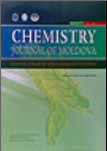Chemistry Journal of Moldova
Research paper
Author(s):
Field: Organic chemistry
Type: Research paper
Issue: 2019 Volume 14, no.2
Pages: 90-96
Jumina Jumina, Rizky Woro Styaningrum, Dwi Siswanta, Sugeng Triono, Yoga Priastomo, Harizal Harizal, Eti Nurwening Sholikhah, Abdul Karim Zulkarnain
Field: Organic chemistry
Type: Research paper
Issue: 2019 Volume 14, no.2
Pages: 90-96
Full Text (PDF): Download
DOI: http://dx.doi.org/10.19261/cjm.2019.624
Abstract (PDF)
Graphical Abstract: Four chalcone derivatives were synthesized and pre-evaluated as broad-spectrum UV protector. Chalcones 1-4 showed a wide range of UV absorbance values and moderate molar absorptivity values. Chalcones 3 and 4 showed better photostability than chalcones 1 and 2 because the lowering of their absorbance was smaller and slower under UVB irradiation. A combination of the spectra of chalcone derivatives 1-4 indicated that a formulation containing all four will provide a broad-spectrum sunscreen protecting the skin from UVA and UVB.

Graphical Abstract: Four chalcone derivatives were synthesized and pre-evaluated as broad-spectrum UV protector. Chalcones 1-4 showed a wide range of UV absorbance values and moderate molar absorptivity values. Chalcones 3 and 4 showed better photostability than chalcones 1 and 2 because the lowering of their absorbance was smaller and slower under UVB irradiation. A combination of the spectra of chalcone derivatives 1-4 indicated that a formulation containing all four will provide a broad-spectrum sunscreen protecting the skin from UVA and UVB.

Downloads: 257
Author(s):
Field: Organic chemistry
Type: Research paper
Issue: 2019 Volume 14, no.2
Pages: 105-116
Nadia Ali Ahmed Elkanzi, Amira Atef Ghoneim, Hajer Hrichi
Field: Organic chemistry
Type: Research paper
Issue: 2019 Volume 14, no.2
Pages: 105-116
Full Text (PDF): Download
DOI: http://dx.doi.org/10.19261/cjm.2019.638
Abstract (PDF)
Graphical Abstract: In this study, novel pyrazole, imidazole, pyrimidine derivatives bearing imidazo[4,5-b]indol moiety were successfully synthesized and their chemical structures were identified and confirmed by different spectral techniques. All the synthesized compounds were tested against four bacterial strains (Bacillus subtilis, Staphylococcus aureus, Escherichia coli, and Pseudomonas aeruginosa) and two fungi (Aspergillus flavus and Candida albicans). The obtained results show that the synthesized compounds could find fruitful applications as antibacterial and antifungal agents in pharmaceutical chemistry.

Graphical Abstract: In this study, novel pyrazole, imidazole, pyrimidine derivatives bearing imidazo[4,5-b]indol moiety were successfully synthesized and their chemical structures were identified and confirmed by different spectral techniques. All the synthesized compounds were tested against four bacterial strains (Bacillus subtilis, Staphylococcus aureus, Escherichia coli, and Pseudomonas aeruginosa) and two fungi (Aspergillus flavus and Candida albicans). The obtained results show that the synthesized compounds could find fruitful applications as antibacterial and antifungal agents in pharmaceutical chemistry.

Downloads: 207
Author(s):
Field: Ecological chemistry
Type: Research paper
Issue: 2019 Volume 14, no.2
Pages: 62-71
Raisa Sircu, Gheorghii Turcanu, Nicolae Opopol, Iurie Pinzaru, Tatiana Manceva, Raisa Scurtu
Field: Ecological chemistry
Type: Research paper
Issue: 2019 Volume 14, no.2
Pages: 62-71
Full Text (PDF): Download
Abstract (PDF)
Graphical Abstract: A total of 5206 samples from twenty-one different vegetables and fruits were collected. Residues of pesticides in concentrations exceeding the maximum residue levels were found in 22.9% of analysed samples. Thirteen insecticides, four fungicides, two acaricides and one herbicide were detected in the analysed samples. The highest value of hazard index was calculated for diazinon – 0.15. The obtained results show that the long-term consumption of vegetables and fruits could pose a health risk for the population of the Republic of Moldova.

Graphical Abstract: A total of 5206 samples from twenty-one different vegetables and fruits were collected. Residues of pesticides in concentrations exceeding the maximum residue levels were found in 22.9% of analysed samples. Thirteen insecticides, four fungicides, two acaricides and one herbicide were detected in the analysed samples. The highest value of hazard index was calculated for diazinon – 0.15. The obtained results show that the long-term consumption of vegetables and fruits could pose a health risk for the population of the Republic of Moldova.

Downloads: 140
Author(s):
Field: Organic chemistry
Type: Research paper
Issue: 2019 Volume 14, no.2
Pages: 97-104
Maryam Shokoohian, Nourallah Hazeri, MalekTaher Maghsoodlou, Mojtaba Lashkari
Field: Organic chemistry
Type: Research paper
Issue: 2019 Volume 14, no.2
Pages: 97-104
Full Text (PDF): Download
Graphical Abstract: 4-(Dimethylamino)pyridine was found to be an efficient homogenous catalyst for one-pot multi-component reactions between hydrazine monohydrate, ethyl cyanoacetate, ketone, and malononitrile for the synthesis of 1,6-diamino-2-oxo-1,2,3,4-tetrahydropyridine-3,5-dicarbonitrile derivatives using ultrasonication at room temperature in ethanol solution within 35-50 min with yields of over 90%.

Downloads: 128
Author(s):
Field: Natural product chemistry and synthesis
Type: Research paper
Issue: 2019 Volume 14, no.2
Pages: 72-78
Svetlana Blaja
Field: Natural product chemistry and synthesis
Type: Research paper
Issue: 2019 Volume 14, no.2
Pages: 72-78
Full Text (PDF): Download
Abstract (PDF)
Graphical Abstract: TThe present paper reports the synthesis of new hybrid terpeno-heterocyclic compounds belonging to di- and tri-norlabdane series. Starting from natural labdane diterpenoide (-)-sclareol, via its intermediates 8α-hydroxy-15,16-dinorlabd-13-one and sclareolide, two di-norlabdane and three tri-norlabdane, previously unreported compounds possessing 2-amino-1,3-thiazole structural units were obtained in three and four steps, respectively, with acceptable to good overall yields. The structures of newly obtained compounds were confirmed by means of spectral IR, 1H and 13C NMR analyses.

Graphical Abstract: TThe present paper reports the synthesis of new hybrid terpeno-heterocyclic compounds belonging to di- and tri-norlabdane series. Starting from natural labdane diterpenoide (-)-sclareol, via its intermediates 8α-hydroxy-15,16-dinorlabd-13-one and sclareolide, two di-norlabdane and three tri-norlabdane, previously unreported compounds possessing 2-amino-1,3-thiazole structural units were obtained in three and four steps, respectively, with acceptable to good overall yields. The structures of newly obtained compounds were confirmed by means of spectral IR, 1H and 13C NMR analyses.

Downloads: 177
Author(s):
Field: Analytical chemistry
Type: Research paper
Issue: 2019 Volume 14, no.2
Pages: 56-61
Livia Uncu, Elena Donici, Vladimir Valica, Oxana Vîslouh, Veaceslav Gonciar, Sergiu Parii
Field: Analytical chemistry
Type: Research paper
Issue: 2019 Volume 14, no.2
Pages: 56-61
Full Text (PDF): Download
Abstract (PDF)
Graphical Abstract: A simple, precise and accurate UV-Vis spectrophotometric method has been developed and validated for the estimation of ciprofloxacin hydrochloride from combination ear drops with basil oil (Ocimum basilicum). The results of the validation of the method demonstrate that the developed method is simple, rapid, accurate and robust over the concentration range 2-10 μg/mL of ciprofloxacin hydrochloride in combination with volatile basil oil.
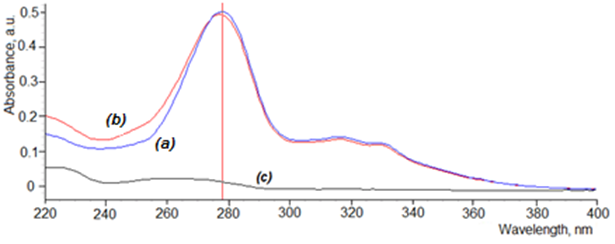
Graphical Abstract: A simple, precise and accurate UV-Vis spectrophotometric method has been developed and validated for the estimation of ciprofloxacin hydrochloride from combination ear drops with basil oil (Ocimum basilicum). The results of the validation of the method demonstrate that the developed method is simple, rapid, accurate and robust over the concentration range 2-10 μg/mL of ciprofloxacin hydrochloride in combination with volatile basil oil.

Downloads: 170
Author(s):
Field: Physical chemistry and chemical physics
Type: Research paper
Issue: 2019 Volume 14, no.1
Pages: 98-106
Nur Nadira Hazani, Yusairie Mohd, Sheikh Ahmad Izaddin Sheikh Mohd Ghazali, Nur Nadia Dzulkifli
Field: Physical chemistry and chemical physics
Type: Research paper
Issue: 2019 Volume 14, no.1
Pages: 98-106
Full Text (PDF): Download
Abstract (PDF)
Graphical Abstract: The inhibitive effects of 2-acetylpyridine 4-ethyl-3-thiosemicarbazone (HAcETSc) and dichlorophenyltin(IV) 2-acetylpyridine 4-ethyl-3-thiosemicarbazone (Sn(HAcETSc)PhenCl2) for mild steel in 1 M HCl solution at different concentrations were investigated using electrochemical measurements and scanning electron microscopy analysis. The result of electrochemical measurement found that the inhibition efficiency increased with inhibitors’ concentration. Moreover, it was shown that that Sn(HAcETSc)PhenCl2 had a better inhibitive effect than HAcETSc.
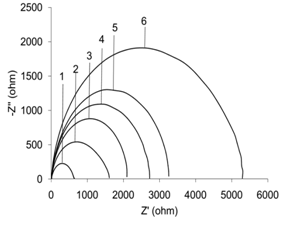
Downloads: 325
Author(s):
Field: Supramolecular chemistry
Type: Research paper
Issue: 2019 Volume 14, no.1
Pages: 120-127
Aliona Vitiu
Field: Supramolecular chemistry
Type: Research paper
Issue: 2019 Volume 14, no.1
Pages: 120-127
Full Text (PDF): Download
Abstract (PDF)
Graphical Abstract: Two new 1D coordination polymers based on octahedral Fe(II) and square-pyramidal Cu(II) complexes and N,N'-bipyridine-type ligands were synthesized by slow evaporation method. The compounds with the formula {(bpyH2)•[Fe(bpy)2(H2O)2(SO4)2]•2(H2O)}n and {[Cu(bpp)2(H2O)]•(BF4)2•dmf•0.75(H2O)}n, (where bpy= 4,4'-bipyridine and bpp= 1,3-bis(4-pyridyl)propane, dmf= N,N-dimethylformamide) were characterized by thermal analysis, FT-IR spectroscopy and single crystal X-ray diffraction method.
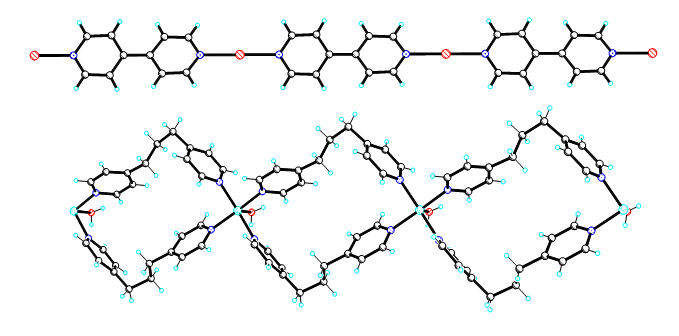
Graphical Abstract: Two new 1D coordination polymers based on octahedral Fe(II) and square-pyramidal Cu(II) complexes and N,N'-bipyridine-type ligands were synthesized by slow evaporation method. The compounds with the formula {(bpyH2)•[Fe(bpy)2(H2O)2(SO4)2]•2(H2O)}n and {[Cu(bpp)2(H2O)]•(BF4)2•dmf•0.75(H2O)}n, (where bpy= 4,4'-bipyridine and bpp= 1,3-bis(4-pyridyl)propane, dmf= N,N-dimethylformamide) were characterized by thermal analysis, FT-IR spectroscopy and single crystal X-ray diffraction method.

Downloads: 233
Author(s):
Field: Physical chemistry and chemical physics
Type: Research paper
Issue: 2019 Volume 14, no.1
Pages: 107-119
Yuri Mirgorod, Alexander Chekadanov, Tatiana Dolenko
Field: Physical chemistry and chemical physics
Type: Research paper
Issue: 2019 Volume 14, no.1
Pages: 107-119
Full Text (PDF): Download
Abstract (PDF)
Graphical Abstract: Aqueous micellar solutions of sodium dodecyl sulphate were investigated using X-ray scattering technique by a model-independent approach and dynamic light scattering in the concentration range 0.008 – 0.1 M. The obtained results are discussed in the framework of the concept of polyamorphous transition between ensembles of water clusters of low and high density levels. Polyamorphous transition accompanies the formation of dual structures of contact and separated by water micelles with different rates of diffusion.

Graphical Abstract: Aqueous micellar solutions of sodium dodecyl sulphate were investigated using X-ray scattering technique by a model-independent approach and dynamic light scattering in the concentration range 0.008 – 0.1 M. The obtained results are discussed in the framework of the concept of polyamorphous transition between ensembles of water clusters of low and high density levels. Polyamorphous transition accompanies the formation of dual structures of contact and separated by water micelles with different rates of diffusion.

Downloads: 271
Author(s):
Field: Ecological chemistry
Type: Research paper
Issue: 2019 Volume 14, no.1
Pages: 61-67
Gheorghe Duca, Aliona Mereuta, Natalia Velisco, Claudiu Tanaselia, Tatiana Mitina
Field: Ecological chemistry
Type: Research paper
Issue: 2019 Volume 14, no.1
Pages: 61-67
Full Text (PDF): Download
Abstract (PDF)
Graphical Abstract: This study presents an assessment of water quality of Prut River using the Water Quality Index (WQI), calculated according to the weighted arithmetic water quality index method. The obtained results show that the water of Prut River may be classified according to WQI as good water quality of grade B for sampling points Sculeni and Cislita-Prut villages, and very poor water quality of grade D collected in the sampling point Criva village.
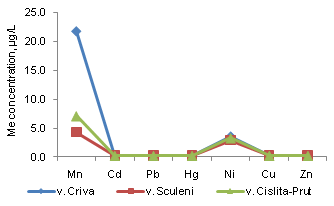
Downloads: 187
